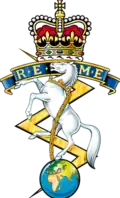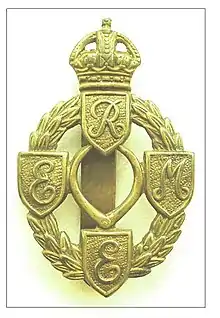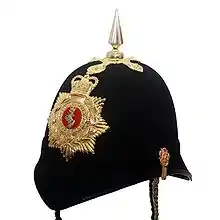| Corps of Royal Electrical and Mechanical Engineers | |
|---|---|
 Cap badge of REME | |
| Active | 1 October 1942 – present |
| Country | |
| Branch | |
| Size | 8,032 personnel |
| Garrison/HQ | MoD Lyneham |
| Motto(s) | Arte et Marte (Latin for "By Skill and By Fighting") |
| Colours | Blue Yellow Red |
| March | "Lillibullero" |
| Commanders | |
| Colonel-in-Chief | The Duchess of Edinburgh |
| Master General | Major General David J. Eastman |
| Insignia | |
| Tactical Recognition Flash | |
 |
| Arms of the British Army |
|---|
| Combat Arms |
| Combat Support Arms |
| Combat Services |
|
|
The Corps of Royal Electrical and Mechanical Engineers (REME /ˈriːmiː/ REE-mee) is the maintenance arm of the British Army that maintains the equipment that the Army uses. The corps is described as the "British Army's Professional Engineers".[1]
History
Prior to REME's formation, maintenance was the responsibility of several different corps:
- Royal Army Ordnance Corps—weapons and armoured vehicles
- Royal Engineers—engineering plant and machinery, and RE motor transport
- Royal Corps of Signals—communications equipment
- Royal Army Service Corps—other motor transport
- Royal Artillery—heavy weapons artificers
During World War II, the increase in quantity and complexity of equipment exposed the flaws in this system. Pursuant to the recommendation of a Committee on Skilled Men in the Services chaired by William Beveridge, the Corps of Royal Electrical and Mechanical Engineers was formed on 1 October 1942.[2][3]
Phase I
Such a major re-organisation was too complex to be carried out quickly and completely in the middle of a world war. Therefore, the changeover was undertaken in two phases. In Phase I, which was implemented immediately, REME was formed on the existing framework of the RAOC Engineering Branch, strengthened by the transfer of certain technical units and tradesmen from the RE and RASC.
At the same time, a number of individual tradesmen were transferred into REME from other corps. The new corps was made responsible for repairing the technical equipment of all arms with certain major exceptions.
REME did not yet undertake:
- Those repairs that were carried out by unit tradesmen who were driver/mechanics or fitters in regiments and belonged to the unit rather than being attached to it.
- Repairs of RASC-operated vehicles, which remained the responsibility of the RASC; each RASC Transport Company had its own workshop.
- Repairs of RE specialist equipment, which remained the responsibility of the RE.[4]
Phase II
In 1949, it was decided that "REME Phase II" should be implemented. This decision was published in Army Council Instruction 110 of 1949, and the necessary reorganisation was carried out in the various arms and services in three stages between July 1951 and January 1952. The main changes were:
- The transfer to REME of most of the unit repair responsibilities of other arms (Infantry, Royal Artillery, Royal Armoured Corps etc.).
- The provision of Light Aid Detachments for certain units that had not possessed them under the old organisation.
- The provision of new REME workshops to carry out field repairs in RASC transport companies. Maintenance of vessels of the RASC fleet whilst in port was given to the fleet repair branch, a civilian organisation which came under the REME umbrella.
This organisation was also responsible for arranging and overseeing ship refits.[4]
Cap badges

After some interim designs, the badge of the Corps was formalised in June 1943 for use as the cap-badge, collar-badge, and on the buttons. It consisted of an oval Royally Crowned laurel wreath; on the wreath were four small shields at the compass points, each shield bearing one of the letters of "REME".[5] Within the wreath was a pair of calipers.[6] Examples of these early badges can be found at the REME Museum. In 1947, the Horse and Lightning was adopted as the cap badge,[7] designed by Stephen Gooden R.A.[8]
Major Ivan Hirst REME and Volkswagen
At the end of the war, the Allies occupied the major German industrial centres to decide their fate. The Volkswagen factory at Wolfsburg became part of the British Zone in June 1945 and No. 30 Workshop Control Unit, REME, assumed control in July. They operated under the overall direction of Colonel Michael McEvoy at Rhine Army Headquarters, Bad Oeynhausen. Uniquely, he had experience of the KdF Wagen in his pre-war career as a motor racing engineer; whilst attending the Berlin Motor Show in 1939, he was able to test drive one.[9]
After visiting the Volkswagen factory, McEvoy had the idea of trying to get Volkswagen back into production to provide light transport for the occupying forces. The British Army, Red Cross and essential German services were chronically short of light vehicles. If the factory could provide them, there would be no cost to the British taxpayer and the factory could be saved. To do this, a good manager with technical experience would be needed. Maj. Ivan Hirst was told simply to "take charge of" the Volkswagen plant before arriving in August 1945. He had drains fixed and bomb craters filled in; land in front of the factory was given over to food production.[9]
At first, the wartime Kubelwagen was viewed as a suitable vehicle. Once it became clear it could not be put back into production, the Volkswagen saloon or Kaefer (Beetle) was suggested. Hirst had an example delivered to Rhine Army headquarters, where it was demonstrated by Colonel McEvoy. The positive reaction led to the Military Government placing an order for 20,000 Volkswagens in September 1945.[9]
Museum
The REME Museum is based at MoD Lyneham.[10]
Training
The Defence School of Electronic and Mechanical Engineering at MoD Lyneham meets most of the training needs of the corps.[11]
Units
With minor exceptions, the Corps is responsible for the examination, modification, repair and recovery of all mechanical, electronic, electrical and optical equipment of the Army beyond the capacity of unit non-technical personnel. REME has its Regimental Headquarters co-located with 8 Training Battalion REME based in MoD Lyneham, Wiltshire. All trade training and Artificer training of electro/mechanical trades of REME and various related training to other units within the British Army, Navy and Air Force is conducted by 8 Training Battalion REME. In line with Army 2020 Refine, there are seven regular, one training and three Army Reserve battalions within REME. Alongside these major units, all battalion sized units within the army have a workshop integrated, made up of REME soldiers, called a Light Aid Detachment (LAD).
|
|
_abseil_from_an_Army_Air_Corps_Lynx_helicopter_MOD_45148285.jpg.webp)

Separate Units
- Regimental Headquarters, at Prince Philip Barracks, MoD Lyneham[15]
- Falkland Islands Motor Transport Workshop[16]
- BATUS Workshop[16]
- BATUK Workshop, HQ in Nanyuki (small rear workshop in Nairobi)[16]
- Brunei Garrison Workshop[16]
- Cyprus Force Workshop Company, HQ at RAF Akrotiri (part of the Cyprus Service Support Unit)[16]
- Land Warfare Centre Battlegroup Light Aid Detachment, at Harman Lines, Warminster Garrison[17]
- Lightning Bolts Army Parachute Display Team, the parachute display team of REME, one of the four official Army Parachute Display Teams.[18]
List of Directors of Electrical and Mechanical Engineering / Master General REME
The head of REME was officially known as Director of Electrical and Mechanical Engineering (Army) or DEME(A).
- Major-General Eric Rowcroft (1942 to 1946)[19]
- Major-General William (Bill) S Tope (1947 to 1949)
- Major-General Stanley William Joslin (1950 to 1953)
- Major-General Wilfred Austin Lord (1954 to 1957)
- Major-General Sir Leslie Norman Tyler (1957 to 1960)
- Major General Denis Redman (1960 to 1963)[20]
- Major General Sir Leonard Henry Atkinson (1963 to 1966)[21]
- Major-General A McGill (1966 to 1968)
- Major-General Peter Howard Girling (1969 to 1972)
- Major-General A M McKay (1972 to 1975)
- Major-General Hugh Macdonald-Smith (1975 to 1978)
- Major-General J V Homan (1978 to 1979)
- Major-General Pat Lee (1979 to 1981)
- Major-General T B Palmer (1983 to 1985)
- Major-General J Boyne (1985 to 1988)
- Major-General D Shaw (1988 to 1991)
- Major-General M S Heath (1991 to 1993)
- Major-General P J G Corp (1993 to 1997)
- Major-General Peter V R Besgrove (1997 to 1999)
- Brigadier Roderick J Croucher (1999 to 2002)
- Brigadier Stephen Tetlow (2002 to 2005)
- Brigadier N T S Williams (2005 to 2007)
- Brigadier B W McCall (2007 to 2010)
- Brigadier M J Boswell (2010 to 2012)
In 2012 a new post of Master General REME was created with Lieutenant General Andrew Figgures as the first incumbent.[22]
- Lieutenant General Andrew Figgures (2012 to 2017)
- Lieutenant General Paul Jaques (2017 to 2023)
- Major-General David James Eastman, MBE (2023 to present)[23]
List of Colonel Commandants
See also
References
- ↑ "Corps of Royal Electrical and Mechanical Engineers". www.army.mod.uk. Retrieved 9 May 2020.
- ↑ "Our history". Ministry of Defence. Retrieved 9 May 2014.
- ↑ William H. Beveridge (2014) [1943]. The Pillars of Security (Works of William H. Beveridge). Taylor & Francis. ISBN 978-1-317-57304-3.
- 1 2 "Royal Electrical and Mechanical Engineers: A history". Retrieved 9 May 2014.
- ↑ Robert Wilkinson-Latham, Discovering British Military Badges and Buttons, Shire Publications Ltd 2006 ISBN 0-7478-0484-2 (p.27)
- ↑ Journal of the Society for Army Historical Research, Volume 25 (London 1947) (p. 171)
- ↑ "The Aims of the REME Association". Retrieved 9 May 2014.
- ↑ D.J. Wright (1982). The History of R.E.M.E. Cap Badge. R.E.M.E. Journal, April 1982, pp 38-41.
- 1 2 3 REME Archives - Arborfield
- ↑ "New REME Museum moves into new home in Lyneham". Gazette and Herald. 18 January 2016. Retrieved 23 June 2018.
- ↑ "Defence School of Electronic and Mechanical Engineering". British Army. Retrieved 21 July 2018.
- ↑ "6 Armoured Close Support Battalion REME". British Army. Retrieved 27 March 2019.
- ↑ "7 Aviation Support Battalion (Official Website)". Retrieved 7 August 2017.
- ↑ "Welcome to 101 Battalion REME". Ministry of Defence. Archived from the original on 13 October 2007. Retrieved 19 September 2018.
- ↑ "Corps of Royal Electrical and Mechanical Engineers". www.army.mod.uk. Retrieved 9 November 2021.
- 1 2 3 4 5 Peregrine & Croucher, pp. 383–398
- ↑ "Google Maps". Google Maps. Retrieved 15 April 2021.
- ↑ "Army Parachute Display Teams". Ministry of Defence. Retrieved 5 September 2022.
- ↑ "Maj Gen Sir Eric Bertram Rowcroft, CB, KBE, M.I. Mech.E., M.I.E.E. 1891 – 1963" (PDF). Retrieved 9 May 2014.
- ↑ "Major-General Denis Redman". The Telegraph. 10 August 2009. Retrieved 19 December 2013.
- ↑ "ATKINSON, Sir Leonard Henry (1910-1990), Major General". Liddell Hart Centre for Military Archives. King's College London. Retrieved 23 December 2013.
- ↑ "REME soldiers march through Wokingham for the last time". Get Reading. 15 June 2015. Retrieved 31 March 2018.
- 1 2 3 4 5 6 "No. 64276". The London Gazette (Supplement). 2 January 2024. p. 26495.
Further reading
- Durie, William (2012). The British Garrison Berlin 1945 - 1994: nowhere to go ... a pictorial historiography of the British Military occupation / presence in Berlin. Berlin: Vergangenheitsverlag (de). ISBN 978-3-86408-068-5. OCLC 978161722.
- Peregrine, Colonel R. B.; Croucher, Brigadier R. J. (2017). Craftsmen of the Army: The Story of the Royal Electrical and Mechanical Engineers. Vol. III: 1993 – 2015. Barnsley, South Yorkshire, United Kingdom: Pen & Sword Military. ISBN 978-1473899889. OCLC 990984905.
- RHQ Royal Electrical and Mechanical Engineers (2017). Craftsmen of the Army: The Story of the Royal Electrical and Mechanical Engineers, 1993-2015. Pen & Sword. ISBN 9781473899902.
- REME, Craftsmen of the Army Vol 2 1969–1992 (1996)
- REME, Craftsmen of the Army Vol 1 1942–1968 (1970)